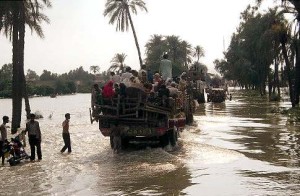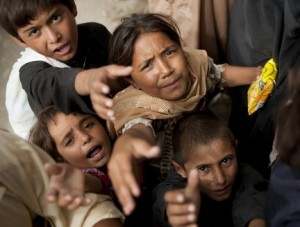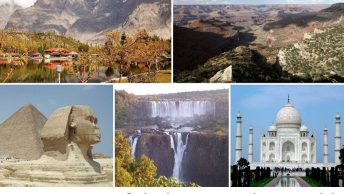
The UN has called it one of the worst natural disasters in history. Less than two months ago Pakistan fell apart, literally. By the end of July 2010, Pakistan was declared a state of emergency as heavy monsoon rains covered most of the country including the regions of Khyber Pakhtunkhwa, Sindh, Punjab and Balochistan.
People were able to evacuate but by estimated 1,600 people have died as a result of the flooding and over 6 million people are estimated to be homeless according to Reuters. This is by far the biggest devastation Pakistan and the world has ever seen.
As the floods began to get worse some Pakistani’s remained behind to protect their homes from the looters who may appear after the floods subsided. They watched as neck deep waters destroyed everything around them and took away their homes. A few food vouchers were given out to those survivors who had remained behind to protect their homes. Without very much food available the vouches proved to be useless.
“We have nothing to eat, we just sit here and wait, sometimes we get food and sometimes we do not. It’s a small amount, a small bag. We are sitting under the hot sun.” – Reuters (YouTube)
Those who did leave are just now beginning to make their way back to their homes to discover what, if any, pieces of their homes are left. Many are traveling home by foot, as they have no other mode of transportation around the waters that remain. The US has helped by providing temporary bridges to help travelers get to their destinations.
Devastation is continuing as they are beginning to return home and find that flood waters have wiped out their homes completely. Some of those who are returning are being held at gunpoint by those who stayed behind as they are try to protect what is left of their possessions. Instead of working together to begin temporarily rebuilding, people are beginning to turn against each other.
With mud houses and homes being destroyed all over the county, many have turned to the Pakistani government for help, but found very little response since the initial flooding began. For the most part the government has not been seen and Pakistanis are relying on private relief agencies for help. Between both the government and private relief agencies only 5 percent of the help that was required had been provided as of the end of July.
Many Pakistani soldiers were involved during the initial two weeks of flooding as they rescued those who were trapped by helicopters, pulling them out to safety. Yet, now that the flood waters have started to go down, the government has not sent help for those who have lost their homes or are looking for simple things such as water clean enough to drink.
The aid is very different than what had been sent to Haiti after the earthquake on January 12, 2010. With many groups still focusing on Haiti, some say that Pakistan hasn’t received nearly the amount of help it needs
Pakistan Turned to Outside Help
A number of smaller areas in Northern Pakistan have received aid packages from Islamic militant activists, yet not nearly enough to cover all of the areas that have been affected. The US has sent aid in the forms of food distribution in early August to some areas that were still waiting for relief. Food was sent in by boat and helicopter to reach those in need. The temporary bridges that were built not only are helping Pakistanis return to their homes, yet they are also helping relief efforts as other countries and private organizations send in help.
The UN Secretary-General Ban Ki-Moon initially requested $460 million to help with emergency relief. As of mid-August only 50% of the $460 million had been received. The additional 50% is still needed to help prevent some of the future problems in Pakistan as the flood cleanup begins.
The immediate concern was the number of those who were killed by the initial floods as well as the number of families who remain homeless. Many are now concerned that with the amount of damage done and lack of food and drinking water, diseases will spread quickly killing more than the initial 1,600 people. Until families are able to have access to clean drinking water as well as a chance to rebuild their homes the concerns will remain.
As many look for dry land to build at minimum a temporary home, the reality of the crop damage hits as well. According to Nasir Cheema, president of Pakistan’s Chamber of Agriculture, production of rice, sugarcane and corn may be cut between 10 and 15 percent affecting more than just those living in Pakistan.
The Pakistani farmers no longer have a source of income, and the people of Pakistan have lost a major food supply. It could take years to rebuild the farms and crops that were being grown and exported. Those who relied on the exported crops will also begin to feel the effects as the exports are delayed.
How Can You Help?

Websites such as Save the Children are taking donations to send money over to Pakistan. Donations are being matched up to $100,000. Money will go to families with children to help aid them in gaining access to clean water and food.
Hillary Clinton has also announced a campaign for Americans to text SWAT to the number 50555 to donate $10 per SMS message. This will go to the UN High Commissioner for providing items in need such as tents, food, clean water, and medicine.
DIRJournal.com is offering up 20% off as well as two free links if you donate to the flood victims. Sign up for DIRJournal.com in the next 15 days and 25% of your cost will be donated to help those in need.
2010 has been a year full of natural disasters around the world. With the monsoon rains catching the people of Pakistan off guard the floods have devastated the country. There is not an end in sight to rebuilding for all of those who have lost their homes. For now the simple things such as clean water to drink and food to eat are the first steps to starting fresh after the floods.













